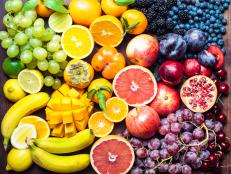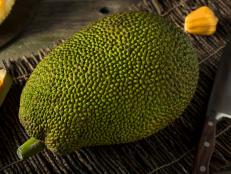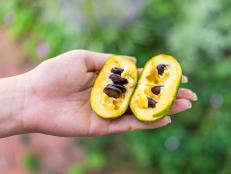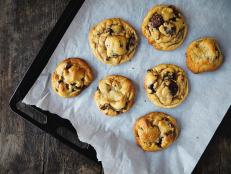How To Sweeten Desserts With Fruit Instead of Sugar
The general rule of thumb is to substitute half the amount of sugar in a recipe with fruit puree. We tested the best fruits for the bill.
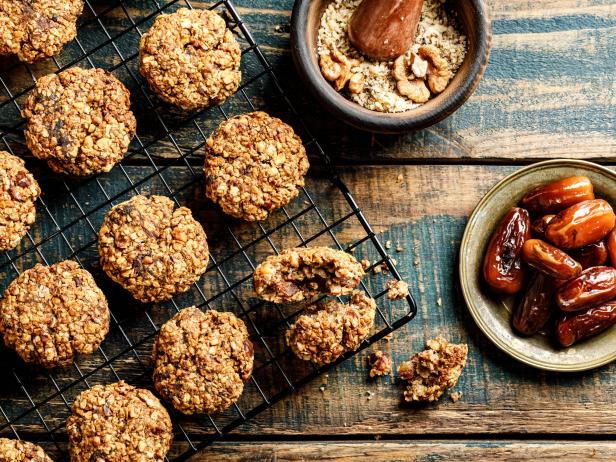
ivandzyuba/Getty Images
You may want to get rid of sugar from your pantry. Or at least switch up your baking ingredients to include more sweet fruit and less sugar.
Why? Simply put, fruits offer more good nutrition than sugar. Unlike sugar, whole fruit is rich in fiber and can help slow down blood sugar spikes after eating those sweet treats. On top of that, fruits provide antioxidants and contain important vitamins and minerals, including potassium, magnesium and vitamin C.
Compared to low-calories sweeteners, which can sometimes add unwanted (menthol) flavors or an unusual aftertaste, fruits can actually enhance your baked goods. For example, prunes can help produce golden brown color, and can keep them fresh and moist. Additionally, the richness of chocolate can be intensified with the addition of prunes, and dates can add a caramel note to desserts.

MAIKA 777/Getty Images
Which Fruits Are Best as Sweetener Substitutes?
Dried fruits are a concentrated form of sugar. The fruits that work best to replace sugar include prunes, raisins and dates, along with fresh bananas. In order to do so, simply make a puree of these fruits so they distribute evenly throughout the treat.
When swapping out sugar with fruit, the very general rule is: Substitute up to half of the sugar with fruit puree in one-bowl cake, quick bread or muffin recipes. If you only swap half the sugar, you shouldn’t have to decrease the liquid ingredient amounts.
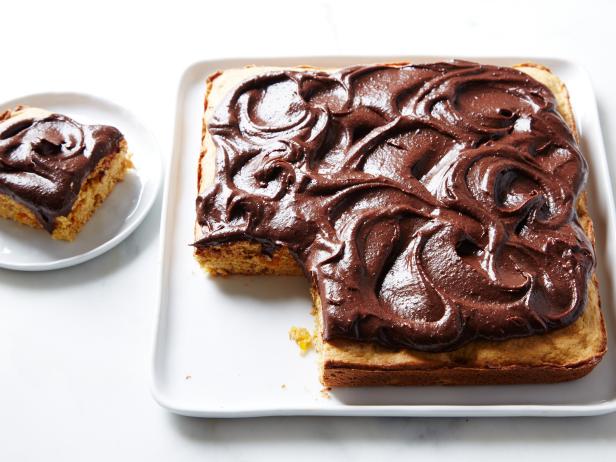
Stephen Johnson, 2016, Television Food Network, G.P. All Rights Reserved
Get the Recipe: Fruit-Sweetened Snack Cake with Chocolate Frosting
Tips for Sweetening with Fruit
Usually you can’t substitute 1:1 sugar to fruit purees. That’s because in light and fluffy baked goods like cakes, sugar provides more than just sweetness; it also lends tenderness, and when whipped up with butter, it provides leavening.
However, in denser baked goods, you may not detect much of a difference with a full substitution of fruit instead of sugar.

Stephen Johnson, © 2016, Television Food Network, G.P. All Rights Reserved
Get the Recipe: Fruit-Sweetened Chocolate Frosting
Here are a few more tips:
- Fruit purees work best in dense baked goods like quick breads, muffins, pancakes, snacking cakes and brownies.
- When mixing up batters, mix fruit purees into the wet ingredients, before adding to the dry ingredients.
- Check baked goods earlier than specified baking times. Fruits are a darker color than sugar and can make batter darker in color. This attracts more oven heat (just like darker pans) and bakes some batters faster.
- Allow baked goods using fruit purees to cool completely before cutting, otherwise they may crumble apart.
- Some baked goods stay fresh longer when fruit purees are used because of the antioxidants in fruits, which act as natural stabilizers.
- You may be able to substitute 1:1 sugar to fruit puree in desserts that aren’t baked, like this chocolate frosting.
- Experiment and have fun. Your results will still be delicious – even if they’re not exactly like the original sugar-sweetened treat.
How to Sweeten Desserts with Fruit Purees
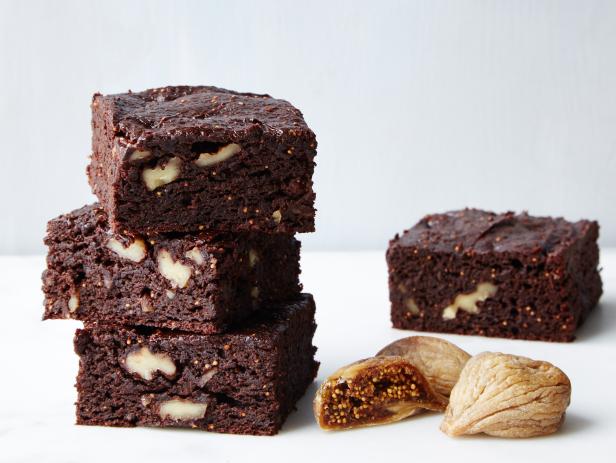
Stephen Johnson, 2016, Television Food Network, G.P. All Rights Reserved
Get the Recipe: Fruit-Sweetened Fig and Walnut Brownies
Prunes
This is our go-to fruit for replacing sugar with fruit. Prunes have a lower glycemic index (GI=29) than most dried fruits and bananas (GI=51). And besides the potassium and magnesium contained in most fruits, prunes also contain zinc for immune health and bone-building nutrients calcium, boron and vitamin K.
Prune puree also adds desirable characteristics like browning and a high level of antioxidants to baked goods; these antioxidant phenols can naturally stabilize baked goods, keeping them fresher.
How to Make Prune Puree: Combine one cup (about eight ounces by weight) of tightly packed prunes with 1/4-cup of hot water in a blender or food processor; blend until smooth. (No need to soak prunes ahead of time.)
Use prune puree to replace up to half of the sugar, maple syrup, honey or other sweetener in a recipe.
It works in most baking recipes, and especially well in chocolate, caramel and spiced desserts, like this carrot cake (we subbed one cup of prune puree for one cup of sugar; the cake was done earlier than the specified time).
Prune puree can also be used in spicy or savory-sweet sauces like barbeque sauce.
Raisins
While raisins are often already thought of as an ingredient in baked goods, they can also be processed into a sugar substitute. Nutritionally, the resulting puree has slightly more potassium than prunes or dates. It’s also rich in antioxidants and fiber.
How to Make Raisin Puree: Cover one cup of raisins with boiling water. Raisins can also be steeped with cinnamon, ginger or other spices; if using spices, steep for 10 to 15 minutes. Then, puree with at least 1/4- to 1/2-cup soaking water, depending on how much spice flavor is desired.
Use raisin puree to replace up to half of the sugar, maple syrup or honey in a recipe.
How to Make Raisin Sugar: Freeze raisins overnight. Quickly pulse frozen raisins with a little flour in the food processor. Use quickly before melting.
Use to replace up to half of the sugar in some desserts. This one will take some experimenting!
Dates
Like raisins and prunes, dates contain magnesium, iron, calcium and potassium. We like both Medjool and Deglet Noor dates. Date puree contains more fiber than raisin puree, but less fiber than prune puree. Date puree contains more calories and carbohydrates than both prune and raisin puree, but it also tastes sweeter.
How to Make Date Puree: Place one cup of tightly-packed whole dates in a jar, cover with warm water and soak for 10 minutes. Drain and reserve warm water. Pit the dates if not pitted. Puree dates and 1/4-cup of warm soaking water in a food processor.
Date puree works especially well as a substitute for honey or maple syrup since the color and flavors are similar. It can be substituted 2:1 puree to the amount of honey in a recipe, since honey is sweeter than sugar.

Matt Armendariz
Get the Recipe: Sugar-Free First Birthday Cake
Bananas
Bananas are not as rich in antioxidants, fiber or vitamins as most dried fruit. However, they are a source of potassium and fiber, with more fiber when they are a little under-ripe (use bananas before they get brown for more fiber). You will taste the banana flavor, unlike the dried fruit purees, which are usually not detectable.
How to Make Banana Puree: Simply peel a banana and mash it.
Swap out up to half of the sugar in a recipe; substitute 2:1 banana puree for sugar.
Banana puree works best in chocolate, coffee or tropical treats – where the flavor of banana will be welcome.
For more fruit-sweetened recipes, check out these six fully fruit-sweetened desserts and Sugar-Free First Birthday Cake.
*This article was written and/or reviewed by an independent registered dietitian nutritionist.
Serena Ball, MS, RD is a registered dietitian nutritionist, culinary instructor, and mom of five children. She blogs at TeaspoonOfSpice.com and is the author of the best-selling The 30-Minute Mediterranean Diet Cookbook, Easy Everyday Mediterranean Diet Cookbook and the newly-released The Sustainable Mediterranean Diet Cookbook. Follow her @TspCurry on Instagram.
Related Content:

























